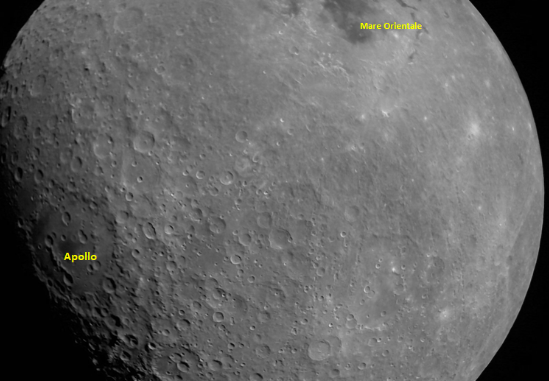ISRO (Indian Space and Research organisation) has released the “first moon image” captured by Chandrayaan 2, which was taken at a height of about 2,650 km from the lunar surface. The image was taken on August 21 at 7.03 P.M. UTC (12.33 a.m. IST on August 22) by the Chandrayaan 2’s LI4 camera, as per the Indian space agency tweeted. Notably, The Mare Orientale basin and Apollo craters are identified in the concerned picture released by ISRO.
Read Also, Chandrayaan-2 launch LIVE: ISRO’s 2nd space mission to Moon
Take a look at the first Moon image captured by #Chandrayaan2 #VikramLander taken at a height of about 2650 km from Lunar surface on August 21, 2019.
— ISRO (@isro) August 22, 2019
Mare Orientale basin and Apollo craters are identified in the picture.#ISRO pic.twitter.com/ZEoLnSlATQ
They also released the first picture of the Earth captured by Chandrayaan 2’s Vikram Lander on Aug 4. On Aug 21, Chandrayaan 2, a day old in its orbit around the moon, started undergoing phased manoeuvres to shorten the elliptical orbit in preparation for the September 7 landing.
It compressed the current elliptical orbitto 4,412 km at the far end from the moon. The orbit exercise was performed for about 20 minutes from 12.50 p.m. by firing the onboard motors. Meanwhile, ISRO chief K. Sivan explained the crucial process of taking up soft landing of the Vikram Lander will be taken up in the early hours of September 7, Indian Space Agency asserted.
Read Also, Chandrayaan-2 Successfully enters Lunar Transfer Trajectory
ISRO scientists in Bengaluru would be engaged in this process which is expected to be completed by 1.55 A.M., he told reporters at the airport in Chennai on August 22. “It is expected to make a soft landing (on the surface of the moon) at around 1.40 a.m. and (the process will be) completed by 1.55 a.m. At the global level this is an important mission. It is being keenly watched by everyone,” he stated to PTI News Agency.
Elaborating about the complexity involved, he argued that the speed of the spacecraft needs to be brought down to “zero”. Chandrayaan 2 successfully entered the lunar orbit on August 20 by performing the Lunar Orbit Insertion (LOI) manoeuvre, The agency reported.
#ISRO
— ISRO (@isro) August 21, 2019
Second Lunar bound orbit maneuver for #Chandrayaan2 spacecraft was performed successfully today (August 21, 2019) beginning at 1250 hrs IST
For details please visit https://t.co/cryo8a7qre pic.twitter.com/MpiktQOyX6
Read Also, ISRO shares Chandrayaan pics, students to see landing
After two more manoeuvres, the Lander will separate from the Orbiter on September 2 and enter into a 100kmX30km orbit around the moon. Then it will perform a series of complex braking manoeuvres to soft land in the South Pole region of the moon.
Read Also, Chandrayaan-2: Moon landing is challenging and tricky
Despite all of this, The lunar South Pole is especially interesting because of the lunar surface area here that remains in shadow is much larger than that at the North Pole. So There is a possibility of the presence of water in permanently shadowed areas around it.
The Earth and the Moon have more in common than just the space they occupy in our lives. Here are some of the ways they affect each other on a day to day basis! #ISRO #MoonMission #Chandrayaan2 pic.twitter.com/h50RDxHlqC
— ISRO (@isro) August 21, 2019
In addition, South Pole region has craters that are cold traps and contain a fossil record of the early Solar System. Chandrayaan-2 will attempt to soft land the lander -Vikram and rover- Pragyan in a high plain between two craters, Manzinus C and Simpelius N, at a latitude of about 70° south, ISRO official read.
Thus, Indian scientists has been created a landmark history followed by country’s 2nd lunar mission, which seeks to explore the far side of the Moon, a feat no other country has achieved yet. If this landing is successful, the 10-billion-rupee mission will allow scientists to carry out studies regarding the presence of water at the Moon’s south pole.
(With the Inputs of ISRO, Content may be edited for style and length.)


